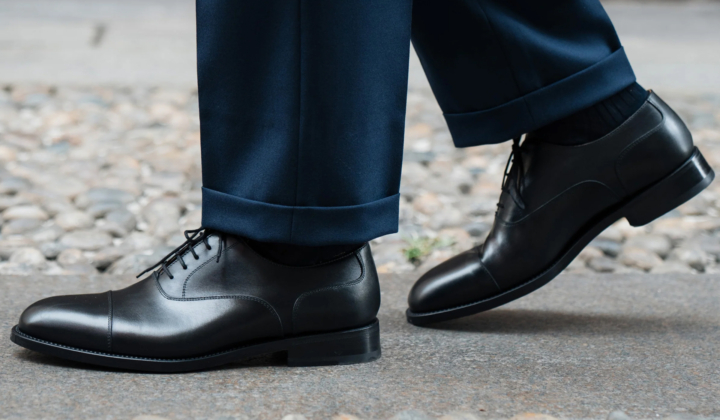A Modern Man’s Guide To The Mohair Suit (And Its Ethical Considerations)
The name itself isn’t so appealing, but the functionality of mohair arguably makes it tailoring’s first technical fibre. Well, kind of. Mohair is made by blending hair from the super-soft, silky, dense undercoat from Angora goats (at least “mohair” sounds better than “goat hair”) together with wool from more run-of-the-mill, plain old sheep. What you get from this magical mix is an usually high warmth to weight ratio, which is to say that it keeps you toasty without weighing you down. More than this, it’s also highly breathable and has a natural springiness to it – crumple a swatch of mohair in your hand and it just seems to automatically unfold, crease-free. It even dyes well, too.
Certainly, while mohair – typically from South Africa, but also sourced from the US and Turkey – offers all sorts of benefits perhaps only expected of the kind of material concocted in a lab, it also has a certain look to it. Its relatively open weave makes it more textural than most suiting fabrics, with the exception of hardy varieties like tweed. Indeed, that relative roughness is why mohair was long rebuffed by more conservative dressers, who typically associated quality cloths with smoothness and density. Even today, mohair tends to divide men – between die-hard devotees and those who just don’t get it.

Sean Connery as James Bond wearing a grey mohair suit in Dr. No (1962)
But there’s another reason why mohair was the choice of everyone from mods (even if they did then wear it to go and fight on beaches), to the cool jazzmen of the 1950s and 1960s, to Sean Connery’s James Bond; why the Four Tops and The Temptations often performed in matching mohair suits; and why Charlie Rich described a dude in his 1965 song as “fast talking, slow walking, good looking, Mohair Sam”. The goat hair content of the mohair gives it a sheen. In fact, the greater the sheen, the greater the mohair content. It’s that sheen that saw mohair once used to make top-end dinner suits. The shine, of course, signals that it’s mohair you’re wearing – thus you stand out of the matte crowd. That’s another reason why the preening mods liked it so much. It’s a sheen that looks lustrous, rather than the cheap shine of nasty synthetics, by the way.

Huntsman Savile Row mohair dinner jacket
Indeed, the modern machinery that makes said synthetics, and most other fabrics these days, often struggles with some forms of mohair cloth, especially the mod favourite called “Tonik”, made by weaving together two different coloured threads – hence its more common name, “two-tone”.
Back in the day, of course, mohair was hand-made. And by “back in the day”, we mean way, way back: the Pharaohs and other ancient Egyptian nobility wore mohair, the goat hair then coming out of Tibet, via Turkey. It tends to be the premium brands that produce mohair garments today – your Tom Fords, Givenchys and Pradas – though, as with so many other “luxury” fabrics, such as cashmere, in recent years there’s been a flood of more basic, mass-market varieties that tend to do a disservice to the qualities that make mohair appealing in the first place.
The Ethical Dilemma
Unfortunately, the price tag isn’t the only reason why you might want to avoid mohair. The fabric has a number of ethical issues that need to be considered, even if you’re careful not to confuse the hair from Angora goats with Angora wool, which is taken from rabbits and a much nastier business altogether.
Firstly, there’s the de-horning of the baby goats, and castration of the males, all without anaesthetics. Then there’s the fact that, since Angora goat workers tend to be piece-workers paid by volume, there have been many reports of them being none too careful come shearing time. A PETA Asia eye-witness investigation documented “rampant abuse”, with many goat kids being shorn heard “screaming in fear and pain”. It’s not only the process that causes distress, either. Angora goats tend to be particularly sensitive to the cold – that’s why they have that dense undercoat in the first place – and yet are often shorn (twice a year, in spring and autumn) in chilly conditions, meaning some then go on to die of exposure.

On top of all that, there is the environmental impact to consider: it takes some 50 pounds of feed to make one pound of mohair, which helps explain its price tag, but which, of course, doesn’t make it all that sustainable. That said, it’s still more sustainable than cashmere, for comparison.
Of course, there’s clearly a better way of getting Angora goat hair without such maltreatment of the goats – none of which, after all, is “necessary” to create the end product. The problem for the time being is that no credible standard has been established for supply chains, although the industry is now making noises about addressing this. Why? Because a few big high-street players – we’re talking huge global names like Gap, Uniqlo, ASOS, H&M and Zara – have agreed to stop selling mohair altogether, at least until producers get their act together. And since mohair production is important to the South African economy, that may yet happen.
Should You Buy A Mohair Suit?
Well, as much as mohair performs superbly, feels distinctive and looks great, you would need to ask some serious questions of your retailer/brand-of-choice before buying. However, with technical fabrics such as merino wool offering comparable performance, and cashmere, silk and blends thereof providing equally luxurious aesthetics, there really is no good reason to support such an out-of-touch, unethical production process.







